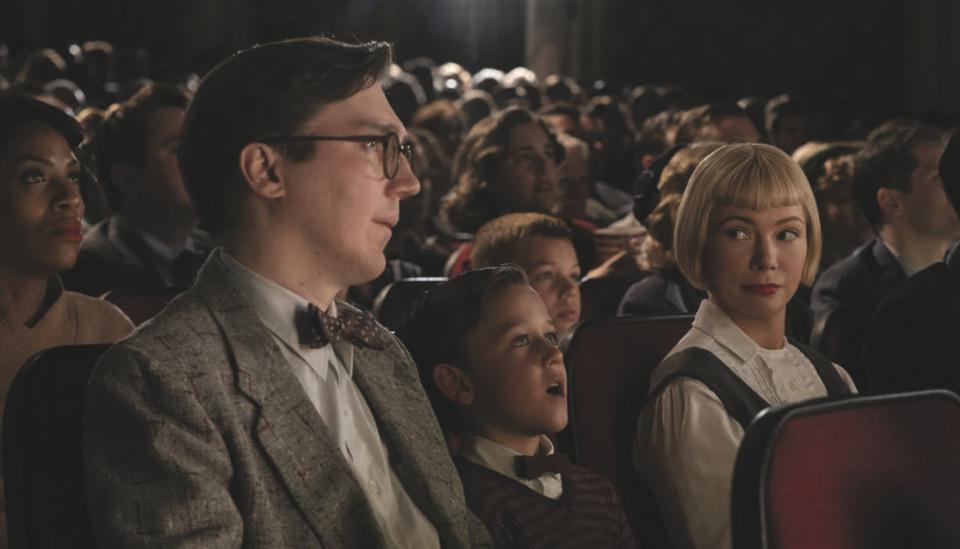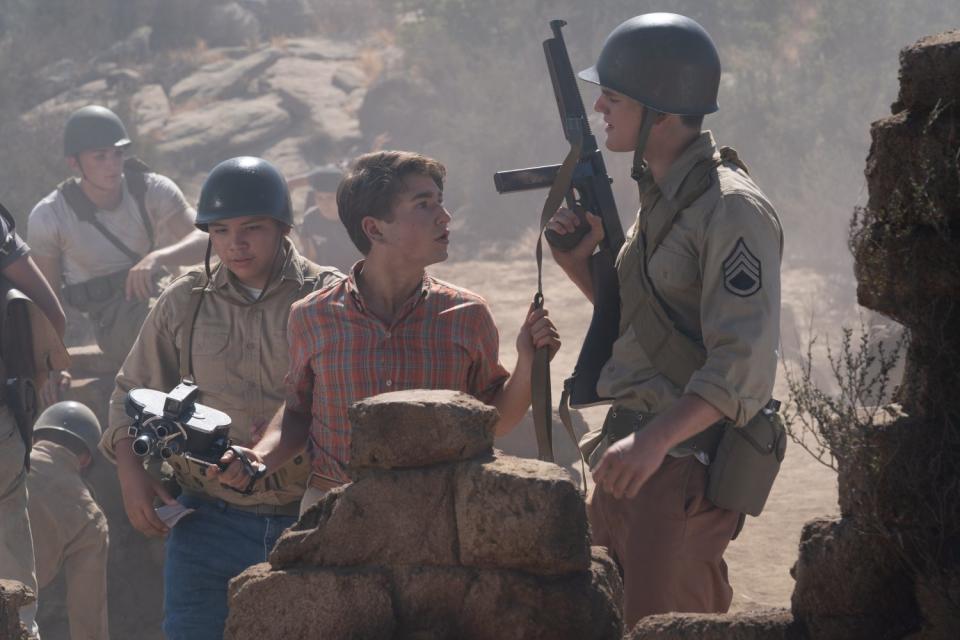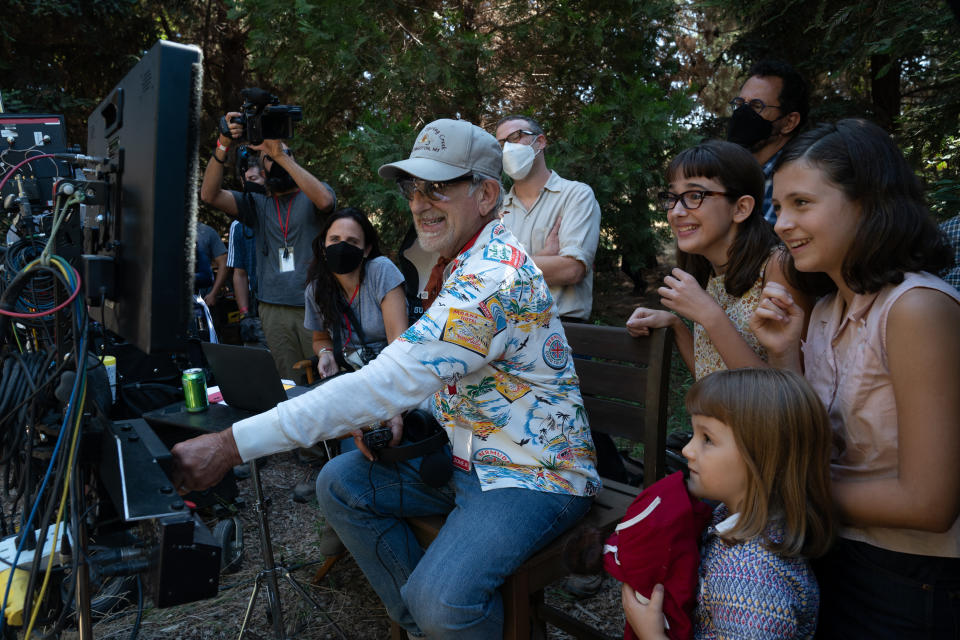Deciphering ‘The Spielberg Code’ with ‘The Fabelmans’

- Oops!Something went wrong.Please try again later.
- Oops!Something went wrong.Please try again later.
- Oops!Something went wrong.Please try again later.
- Oops!Something went wrong.Please try again later.
“The Fabelmans” is billed as Steven Spielberg’s most autobiographical film to date, though viewers who’ve followed the director’s career closely have already absorbed plenty of his life story. Whether or not Spielberg was always aware of this is another question. Recall his episode of “Inside the Actor’s Studio,” in which host James Lipton catches Spielberg off-guard with an observation about “Close Encounters of the Third Kind”: A child of divorce, the son of concert pianist Leah Adler and data processing pioneer Arnold Spielberg had made a movie where humans and extraterrestrials can communicate because “they make music on their computers.” “I’d love to say, ‘You know, I intended that, and I realize that was my mother and father,'” Spielberg tells Lipton, as he cracks a smile. “But not until this moment!”
The splintering of the family unit, characters chasing their dreams or venturing into fantastical realms to escape their home life or restore a lost connection — this is the core of the Steven Spielberg filmography, and the subtext that’s made text by “The Fabelmans.” It’s part of what “Fabelmans” production designer Rick Carter identifies as “the Spielberg code,” the threads tying together the 33 features in the director’s filmography. And Carter would know those threads better than most people, having worked with Spielberg 11 times dating back to “Jurassic Park.”
More from IndieWire
Cinematographer Autumn Durald Arkapaw Is Bringing a Visual Subtlety to the Marvel Cinematic Universe
Seth Rogen Was Mortified That Friends Thought He Was Actually Balding in 'The Fabelmans'
“This is the first time he’s made a movie stripped of metaphor,” Carter says in the “Fabelmans” production notes. “You get insight into who he is, not only as a person and how he developed, but how his art developed and the fact that it is art that has come from a deep place within him.”
In separate interviews about “The Fabelmans” with Carter and cinematographer Janusz Kamiński, IndieWire couldn’t help but notice bits of the Spielberg code peeking through the conversations — as it pertains to the themes it shares with the director’s previous movies, and the pieces of his past he’s now dramatized.

Universal Pictures
Family
Kamiński didn’t have to look far for reference points when telling a story inspired by the Spielbergs; as the director’s go-to director of photography since “Schindler’s List,” he had firsthand knowledge of the characters’ real-life counterparts. “I knew these people,” he said. “I’ve been around the family for close to 30 years.” For the actors, Kaminski said access to Spielberg’s memories and family records was essential. “The actors [became] very familiar with the home movies, and they had extensive conversations about what Arnold was like, what Leah was like, what the sisters were like. And that research comes from Steven allowing those access into his personal life.”
The tension between family and art is a key theme of “The Fabelmans,” most clearly articulated in the scene where Judd Hirsch’s character tells Sammy (the movie’s fictional stand-in for young Spielberg) that the conflict will tear him apart. “You have to choose between the civilian life and the movies,” said Kaminski. “That’s a theme that is very much in my life and the thing that identify with the most in the movie. Perhaps this is also the reason Steven and I have such a good collaboration. He’s less transparent about his choice and I’m more transparent. I really found life in making movies; I found family, I found happiness, I found a form of expression. For me making movies is being alive, as it is for him. But the audience never knew that until this particular movie.”
Production designer Carter found the blending of the biographical and the fictional one of the most enjoyable aspects of working on “The Fabelmans.” Having known both of Spielberg’s parents, he was very aware of the artistic and pragmatic traits that the director inherited from them. “So I had some insight,” he said. “But I also knew that we were making a fable version of a movie, and it was part of that gap that we like to play in, which is between what’s real and where can you take it by interpreting the period. In this case, it was so much about being reflective of his intimate life and trying to make sure that he was comfortable in the world that we set up as mirroring his experience but without being absolutely literal.”
Carter explained that Sammy’s westward journey from New Jersey to Phoenix to Northern California mirrored Spielberg’s and is reflective of a hero’s journey. “Because not only is it moving forward in time, it’s got a three-act structure of having started on the East Coast, and then moving across the desert to California in the sense that the Promised Land turned out to not have the promise that he wanted,” Carter said. “Within that progression, we had a lot of latitude to put in what we wanted, except that one of the things that we paid a lot of attention to was any of the details that Steven or his sisters had remembered of things that they had, specifically the kinds of books and records and toys, or kitchenware we tried to come as close as we could with the set decoration.”
In recreating the three houses from Spielberg’s childhood, each had its own sensibility. Carter worked off floor plans that the director sketched from memory and then took artistic license with the spaces to fit the emotional mindset of Sammy. “But the most interesting one was in Phoenix,” Carter said, “because, as a filmmaker, he became more himself. So not only the equipment that was there is accurate, but all the storyboards that Sammy used to make his movies. And Steven drew all the storyboards, and he still draws his storyboards the way he did as a teenager.

Merie Weismiller Wallace/Univers
Sammy’s Movies
Recreating the movies that Spielberg made as a young man was one area where the filmmakers intentionally deviated from reality just a bit. “We had to make them better than he had done it,” Kaminski said, in order to convince the audience that they were watching the birth of a cinematic genius.
An early scene in which Sammy projects a movie on his hand and stares at it in wonder was the result of a happy accident. “Steven was just looking at that image and he said ‘Wow, that is such a beautiful thing,’” Kaminski said. “That digital projection on his hand was so romantic and such a metaphor of the entire movie: [Sammy] can have the image in his hand and shape it.”
The various craft teams had access to the World War II drama recreated in “The Fabelmans,” “Escape to Nowhere,” which enabled Carter to replicate the adobe area where young Spielberg staged the film’s battle. According to the production designer, such accurate recreations required a delicate balance, so that what’s presented onscreen “is not only what it was — it has a different and even more meaningful resonance based on how [Spielberg] thinks about it now.”

Merie Weismiller Wallace / courtesy of Universal Pictures
Steven’s Movies
Although “The Fabelmans” is more explicit in its autobiographical revelations than Spielberg’s other work, it’s less an outlier than the culmination of the director’s approach to personal filmmaking throughout his career. “Most of the movies are, to some degree, autobiographical,” Kaminski said. “Even when he’s doing a movie such as ‘War of the Worlds,’ it’s still a story about a father trying to connect with his son.” Kaminski noted that the autobiographical elements of other films have been overlooked largely due to Spielberg’s reticence about calling attention to them. “[There are some] filmmakers who really emphasize, through interviews and public appearances, why they make movies. He’s been rather quiet about that. He lets the audience try to figure out who is the man behind the movies.”
Carter had his own epiphanies involving the origins of scenes within other Spielberg movies. One example is the pet Capuchin monkey Sammy’s mom, Mitzi (Michelle Williams), brings home one day because she’s lonely and depressed living in Phoenix. The production designer realized that the Capuchin monkey that saves Indiana Jones’ life in “Raiders of the Lost Ark” by eating the poison date had its roots in Spielberg’s childhood. “Now you see the code and that the monkey actually goes back to his mother,” he said. “It’s not A-to-B clear, it’s the intuitive, associative quality that’s on display in ‘The Fabelmans,’ and has been played out in front of us for 40 years.”
A more personal example of the code occurs when Sammy coaxes an emotionally powerful performance out of his friend Angelo (Stephen Smith) during the climactic scene from “Escape to Nowhere.” The sergeant walks away guilt-ridden, having led his platoon into an ambush. Carter recalled a parallel moment from “Lincoln,” during the aftermath of the Petersburg battle scene, where Lincoln (Daniel Day Lewis) rides through the bodies and talks with General Grant (Jared Harris) about the horrors of the war they’ve been fighting. “Sammy is also using that character to convey something about what he’s feeling about his father and the secret that he’s becoming aware of” — the secret being Mitzi’s feelings for family friend Benny (Seth Rogen), evidence of which Sammy inadvertently catches on film.
For Carter, the ultimate takeaway of the Spielberg code being deciphered in “The Fabelmans” is its impact on other filmmakers. “Any artist watching his movies will be stimulated to think about where their own impulses come from,” he said, “because he’s taking the very medium that he’s used to create the illusions to try and get at the truth but still let it be an illusion.”
Best of IndieWire
Sign up for Indiewire's Newsletter. For the latest news, follow us on Facebook, Twitter, and Instagram.


